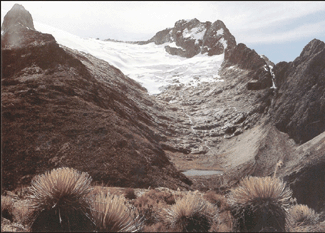Was the Little Ice Age caused by a minimum in the solar cycle?

(Texto only in Catalán)
At the end of the Middle Ages, the northern hemisphere suffered period of climate cooling which, among other things, meant that glaciers descended down the mountains and is therefore known as the Little Ice Age (LIA). The LIA ended around the 18th century, when a period of climate warming began, and continues and which is most probably due to a combination of natural and anthropic causes. The existence of the LIA is known from indirect evidence (proxies) which allows us to reconstruct past climate changes which occurred before the existence of meteorological instruments (paleoclimatic studies), such as the analysis of fossils preserved in lake sediments or the study of historical documents. The cause of the LIA is still a topic of debate. Up till now the two most probable hypotheses are related to volcanic eruptions and short cyclical changes in solar irradiance. We know that during the phases of more frequent volcanic activity, the solar radiation which warms the earth is reduced due to a denser layer of dust and ash which acts as a filter. Additionally the sun has an internal cycle with maximums and minimums of energy emission, which give rise to various manifestations, such as for example sun spots. The LIA, therefore, may have been triggered by a general increase in volcanic activity or by the existence of a minimum in the solar cycle.
This study confirms that the LIA also occurred in the tropics and that the most probable cause was a variation in the incidence of energy due to solar cycles. Prior to this, a palinological study (from pollen preserved in peat) had shown a reduction in vegetation in the high mountains of the Andes, due to a fall in temperature. This happened between the 13th and 18th centuries and correlated with the LIA (Rull et al. 1987). Now we have been able to show that during this period there were four maximums of glacial advance, around the years 1265, 1520, 1685 and 1810, which coincide perfectly with four minimums of the solar cycle. All this is recorded from proxies preserved in high mountain sediments lacustres. The advance of the glaciers has been deduced from the increase in a physical parameter which is known as magnetic susceptibility and which is a reflection of the quantity of magnetic minerals present in the sediments, which can only come from erosion caused by the glaciers on the mother rock of the basin around the lake. The minimums in the solar cycle have been deduced from the increase in the concentration of radioactive isotopes of Carboni and Berili (14C, 10Be), which are more abundant when the solar radiation which arrives to the earth falls. Besides, we have been able to measure that the fall in temperature in the tropics during the SIA was around 3 ºC and that precipitation increased by 20% (both are necessary for glaciers to advance). We have been able to deduce this from a prior measurement which allows us to estimate climate data from biological proxies, such as pollen (Rull 2006).
These results show that the cyclical variations in solar irradiance, while relatively small in size, are able to produce important climatic variations. We now have to discover what the amplifying mechanisms responsible for this effect are. Once we know that, it will be possible to predict with more accuracy the possible consequences of current and future climate change.

Glaciers and sun spots. On the left, the Humboldt glacier, which descends from the peak of the same name (4942 m). We can see the extension that the glacier covered during the SIA, when it covered the laguna which can be seen in the lower part of the picture. On the right, view of the solar sphere with spots, which change in number according to irradiance cycles.

Graph where we can see the exact correspondence (highlighted in grey areas) between the advances of the glaciers during the LIA, at the top, and the minimums of irradiance at the bottom.
References
Article: "Solar modulation of little ice age climate in the tropical Andes",Polissar, P. J., Abbott, M. B., Wolfe, A. P., Bezada, M., Rull, V. & Bradley, R. Proceedings of the National Academy of Sciences USA, 103: 8937-8942. S. 2006


